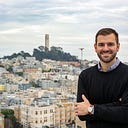San Francisco Can Lead On Economic Recovery by Reimagining Tourist and Retail Heavy Neighborhoods
As I’ve been meeting neighbors and small business owners in District 3 neighborhoods like Fisherman’s Wharf and Union Square, I’ve heard deep concerns and questions about how their neighborhoods, in particular, will survive the coming months and years.
One corner store owner in Nob Hill shared with me this week that his sales are just 20% of what they typically are because of the drop in tourists. A neighbor near Union Square put it simply to me, “Where have all the people gone? When will they come back?”
Many of District 3’s neighborhoods, from Fisherman’s Wharf to the Financial District, are heavily dependent upon tourism and retail. These neighborhoods normalcy all depend on industries that are impacted in this pandemic, from tourism to commercial office tenants to retail. In a city that relies heavily on Hotel and Sales Tax for its revenue, it also explains why we have a budget shortfall of nearly $2 billion looming.
For San Francisco’s economic recovery to be as quick as possible, we must take intentional steps today to support and reimagine these storied neighborhoods. While they may seem “empty” without office workers or tourists, we cannot abandon the residents, essential workers, and small business owners who remain.
Here are four ways these neighborhoods can help to lead our cities’ recovery:
1.) Convert Retail to Residential — Before the pandemic, it was estimated that the United States was oversubscribed on retail space by as much as 30%. This has come to bear with the closures of 24 Hour Fitness and Cost Plus at Fisherman’s Wharf, both announced in the past month. Many of Union Square’s flagship stores are facing bankruptcy.
Let’s make it easy to convert entire floors that were previously retail to a higher priority use: Housing. We can do this by passing narrowly defined legislation to expedite conversions of retail to housing in large spaces while making sure this doesn’t impact small neighborhood businesses.
The result? Thousands of new housing units, neighborhoods with a greater diversity of use, and new property tax revenue for San Francisco.
2.) Support Workers — Many essential workers still commute to these neighborhoods and will be at the center of their recovery. We need to support them in ways large and small, from prioritizing emergency transit lanes to speed up their commutes to allowing more flexibility in our Paid Family Leave ordinances.
Behind each worker is a Small Business. I’m the only candidate to release a COVID Small Business Plan, which we shared in the early moments of the pandemic in March.
3.) Attract Locals With New Experiences — Large parking lots and empty plazas offer space to hold socially-distanced events that our city is growing more eager to participate in. We need to follow all safety guidelines, but it’s possible to imagine drive-in outdoor movie theaters along Fisherman’s Wharf or an Art Walk around Union Square. These types of experiences can appeal to residents, a population that these tourist-heavy neighborhoods need to quickly reach.
As Supervisor, I’ll work with OEWD to support Merchant Groups in their efforts to activate these space and make sure our burdensome permitting system is flexible to allow for these events.
4.) Invest in Infrastructure — Now is the time to invest in infrastructure projects that will prepare our neighborhoods to function better when they’re ready to reopen. This includes everything from reshaping our streets to be safer for families and seniors to large public works projects like park improvements. We can put our city to work and complete construction faster with less congestion to compete with.
To climb out of the Great Depression, we invested in infrastructure that we enjoy to this day. The New Deal fueled everything from the Coit Tower Murals to Aquatic Park. Imagine what we can create today to help our recovery and stand as a testament to our resilience.
Our storied neighborhoods of Fisherman’s Wharf, Union Square, and The Financial District will be back, and I’m confident they’ll be stronger than ever. But, we need to be realistic about what the next few years look like for them. To retain their history and their character, we must move quickly to encourage new uses that keep them vibrant and healthy until then.
Danny Sauter is a renter, non-profit director, and neighborhood organizer. He lives in North Beach. He is running for District 3 Supervisor in November 2020. www.dannyd3.com
